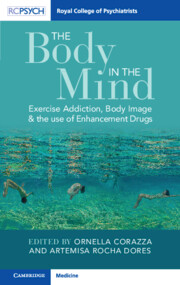Book contents
- The Body in the Mind
- The Body in the Mind
- Copyright page
- Dedication
- Contents
- Figures
- Tables
- Boxes
- Contributors
- Acknowledgements
- Introduction
- Section 1 From Exercise to Addiction: An Introduction to the Phenomenon
- Section 2 Reaching the Extreme with Exercise: A Collection of Clinical Case Studies
- Chapter 11 Being Versus Appearing: Two Sides of the Same Coin?
- Chapter 12 Reducing Excessive Exercise Behaviour Using Online Cognitive–Behavioural Therapy
- Chapter 13 The Story of My Life
- Chapter 14 Money Honey
- Section 3 Exploring the Motivations Behind Exercise Addiction
- Index
- References
Chapter 11 - Being Versus Appearing: Two Sides of the Same Coin?
A Case Report
from Section 2 - Reaching the Extreme with Exercise: A Collection of Clinical Case Studies
Published online by Cambridge University Press: 30 March 2023
- The Body in the Mind
- The Body in the Mind
- Copyright page
- Dedication
- Contents
- Figures
- Tables
- Boxes
- Contributors
- Acknowledgements
- Introduction
- Section 1 From Exercise to Addiction: An Introduction to the Phenomenon
- Section 2 Reaching the Extreme with Exercise: A Collection of Clinical Case Studies
- Chapter 11 Being Versus Appearing: Two Sides of the Same Coin?
- Chapter 12 Reducing Excessive Exercise Behaviour Using Online Cognitive–Behavioural Therapy
- Chapter 13 The Story of My Life
- Chapter 14 Money Honey
- Section 3 Exploring the Motivations Behind Exercise Addiction
- Index
- References
Summary
We are living in an era in which appearance and body image can become the main focus of thoughts and behaviours, resulting in physical, psychological, and social suffering, about which patients, health professionals, and organizations may or may not have insight. This chapter presents the case of a 32-year-old man with body dysmorphic disorder (BDD) who presented for a psychiatric consultation because he believed that his current psychotropic medication was preventing him from achieving his desired body shape. Exercise had become such an overwhelming preoccupation that it was having negative effects on the other areas of his life, and thus required intervention. Possible etiological and maintenance factors, in particular excessive and dysfunctional exercise behaviours (exercise addiction), were explored. Remission of symptoms only occurred after psychotherapy was included as part of the intervention, demonstrating the positive effects of a treatment plan that combines pharmacology with other therapeutic approaches.
Keywords
- Type
- Chapter
- Information
- The Body in the MindExercise Addiction, Body Image and the Use of Enhancement Drugs, pp. 163 - 170Publisher: Cambridge University PressPrint publication year: 2023



